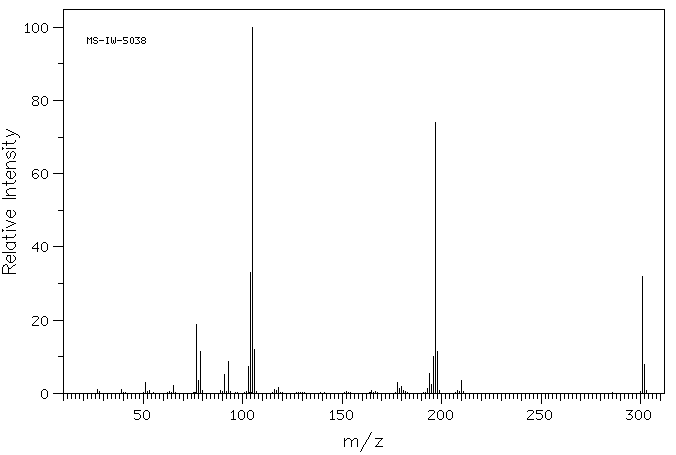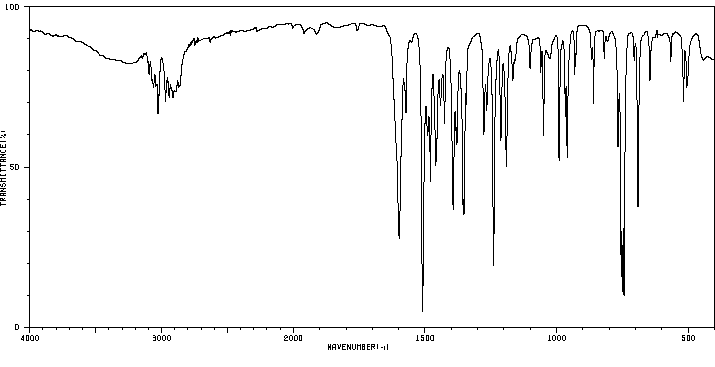N,N-bis(2-methylbenzyl)benzenamine | 908103-13-9
中文名称
——
中文别名
——
英文名称
N,N-bis(2-methylbenzyl)benzenamine
英文别名
N,N-bis(2-methylbenzyl)aniline;N,N-di(2-methylbenzyl)aniline;2,2'-Dimethyl-N-phenyldibenzylamine;N,N-bis[(2-methylphenyl)methyl]aniline
CAS
908103-13-9
化学式
C22H23N
mdl
——
分子量
301.431
InChiKey
CPJVWXGFXSFSQU-UHFFFAOYSA-N
BEILSTEIN
——
EINECS
——
-
物化性质
-
计算性质
-
ADMET
-
安全信息
-
SDS
-
制备方法与用途
-
上下游信息
-
文献信息
-
表征谱图
-
同类化合物
-
相关功能分类
-
相关结构分类
计算性质
-
辛醇/水分配系数(LogP):5.8
-
重原子数:23
-
可旋转键数:5
-
环数:3.0
-
sp3杂化的碳原子比例:0.18
-
拓扑面积:3.2
-
氢给体数:0
-
氢受体数:1
上下游信息
-
下游产品
中文名称 英文名称 CAS号 化学式 分子量 邻酰胺 2-methyl-N-phenylbenzamide 7055-03-0 C14H13NO 211.263
反应信息
-
作为反应物:描述:参考文献:名称:使用可见光诱导的光氧化还原催化的 N,N-二苄基苯胺的非水氧化 C–N 裂解区域选择性合成 2°酰胺摘要:据报道,可见光驱动的光氧化还原催化的N , N -二苄基苯胺的非水氧化 C-N 裂解为 2° 酰胺。此外,我们已将此协议应用于 2-(二苄基氨基) 苯甲酰胺以提供具有 (NH 4 ) 2 S 2 O 8作为添加剂的喹唑啉酮。机理研究表明,该反应可能通过 C-N 键断裂,然后加入超氧离子形成酰胺,原位生成 α-氨基自由基为亚胺。DOI:10.1021/acs.joc.1c01792
-
作为产物:参考文献:名称:醇与负载型金催化剂直接对硝基芳烃进行一锅还原N-烷基化反应摘要:黄金标准支持!不含氢的二氧化钛负载的金催化剂体系有效地促进了使用氢借用策略使芳香族硝基化合物与醇直接还原成单-或二-N-烷基化反应(参见方案)。在不使用任何助催化剂(例如碱和稳定配体)的情况下,可以将各种硝基芳烃以良好的优良性能选择性地转化为相应的仲胺或叔胺。DOI:10.1002/chem.201100393
文献信息
-
Selective N-Alkylation of Amines with Alcohols by Using Non-Metal-Based Acid-Base Cooperative Catalysis作者:Ya Du、Shunsuke Oishi、Susumu SaitoDOI:10.1002/chem.201102446日期:2011.10.24straightforward method for the selective N‐mono‐ and dialkylation of amines with alcohols by means of non‐metal‐based catalysis promoted by TAPC is reported (see scheme). Selectivity of the N‐mono‐ and dialkylation, substrate scope and functional‐group tolerance are highlighted with respect to each amine (1° and 2°; aromatic and aliphatic) and alcohol (1°, 2° and 3°; benzylic and aliphatic) component.
-
Iridium-Catalyzed Alkylation of Amine and Nitrobenzene with Alcohol to Tertiary Amine under Base- and Solvent-Free Conditions作者:Chao Li、Ke-feng Wan、Fu-ya Guo、Qian-hui Wu、Mao-lin Yuan、Rui-xiang Li、Hai-yan Fu、Xue-li Zheng、Hua ChenDOI:10.1021/acs.joc.8b03137日期:2019.2.15and green method for the selective synthesis of tertiary amines has been developed that involves iridium-catalyzed alkylation of various primary amines with aromatic or aliphatic alcohols. Notably, the catalytic protocol enables this transformation in the absence of additional base and solvent. Furthermore, the alkylation of nitrobenzene with primary alcohol to tertiary amine has also been achieved by
-
Metal-free photoredox-catalyzed direct α-oxygenation of <i>N</i>,<i>N</i>-dibenzylanilines to imides under visible light作者:Nalladhambi Neerathilingam、Ramasamy AnandhanDOI:10.1039/d2ra00585a日期:——An efficient synthesis of imides using metal-free photoredox-catalyzed direct α-oxygenation of N,N′-disubstituted anilines in the presence of 9-mesityl-10-methylacridinium [Acr+-Mes]BF4 as a photoredox catalyst and molecular oxygen as a green oxidant under visible light was developed. This photochemical approach offered operational simplicity, high atom economy with a low E-factor, and functional group
-
PROCESS FOR PRODUCING OLEFIN POLYMER申请人:Asahi Kasei Kabushiki Kaisha公开号:EP1336624A1公开(公告)日:2003-08-20A method for producing an olefin homopolymer or an olefin copolymer from an olefin or an olefin and at least one comonomer copolymerizable therewith by continuous slurry polymerization or continuous gaseous phase polymerization in the presence of a metallocene catalyst, the method comprising transferring the catalyst to a polymerizer and introducing the catalyst into the polymerizer while continuously feeding the olefin or the olefin and the comonomer into the polymerizer, to thereby effect a homopolymerization of the olefin or a copolymerization of the olefin and the comonomer, wherein, said catalyst is subjected to hydrogen gas-treatment in which said catalyst is contacted with hydrogen gas. The method of the present invention is advantageous in that continuous production of the olefin homopolymer or an olefin copolymer can be stably performed without the disadvantageous occurrence of indefinite forms of polymer, so that a polymer withdrawal pipe can be prevented from being clogged with such indefinite forms of polymer, thus enabling continuous production of an olefin homopolymer or an olefin copolymer on a commercial scale.
-
PROCESS FOR POLYMERIZATION OF OLEFINS申请人:Asahi Kasei Kabushiki Kaisha公开号:EP1449853A1公开(公告)日:2004-08-25A catalyst for olefin polymerization, comprising: a solid catalyst component comprising [A] a solid component having substantially no hydroxyl group, [B] a compound of a transition metal selected from Groups 3-11 of the Periodic Table, and [C] a mixture of an activator compound (C-1) capable of reacting with the transition metal compound [B] to form a metal complex having catalytic activity and an organoaluminum compound (C-2); and [D] an organomagnesium compound soluble in a hydrocarbon solvent which is obtained by reacting (i) an organomagnesium compound represented by the general formula: (Mt)α(Mg)β(R1)a(R2)b wherein Mt is a metal atom belonging to Groups 1-3 of the Periodic Table, R1 and R2 are hydrocarbon groups of 2-20 carbon atoms, and α, β, a and b are numerals satisfying the following relationship: 0≤α, 0<β, 0≤a, 0≤b, a+b>0, and rα+2β=a+b (where r is a valence of Mt) with (ii) a compound selected from an amine, an alcohol and a siloxane.一种烯烃聚合催化剂,包括 固体催化剂组分,包括 [A] 基本上不含羟基的固体组分、 [B] 一种选自元素周期表第 3-11 族的过渡金属化合物,以及 [C]能与过渡金属化合物[B]反应形成具有催化活性的金属络合物的活化剂化合物(C-1)和有机铝化合物(C-2)的混合物;以及 [D]一种可溶于烃类溶剂的有机镁化合物,它是由(i)通式为......的有机镁化合物与......反应得到的: (Mt)α(Mg)β(R1)a(R2)b 其中 Mt 是属于元素周期表 1-3 族的金属原子,R1 和 R2 是含有 2-20 个碳原子的烃基,α、β、a 和 b 是满足以下关系的数字:0≤α,00,和 rα+2β=a+b(其中 r 是 Mt 的化合价)与 (ii) 选自胺、醇和硅氧烷的化合物。
表征谱图
-
氢谱1HNMR
-
质谱MS
-
碳谱13CNMR
-
红外IR
-
拉曼Raman
-
峰位数据
-
峰位匹配
-
表征信息
同类化合物
(βS)-β-氨基-4-(4-羟基苯氧基)-3,5-二碘苯甲丙醇
(S,S)-邻甲苯基-DIPAMP
(S)-(-)-7'-〔4(S)-(苄基)恶唑-2-基]-7-二(3,5-二-叔丁基苯基)膦基-2,2',3,3'-四氢-1,1-螺二氢茚
(S)-盐酸沙丁胺醇
(S)-3-(叔丁基)-4-(2,6-二甲氧基苯基)-2,3-二氢苯并[d][1,3]氧磷杂环戊二烯
(S)-2,2'-双[双(3,5-三氟甲基苯基)膦基]-4,4',6,6'-四甲氧基联苯
(S)-1-[3,5-双(三氟甲基)苯基]-3-[1-(二甲基氨基)-3-甲基丁烷-2-基]硫脲
(R)富马酸托特罗定
(R)-(-)-盐酸尼古地平
(R)-(-)-4,12-双(二苯基膦基)[2.2]对环芳烷(1,5环辛二烯)铑(I)四氟硼酸盐
(R)-(+)-7-双(3,5-二叔丁基苯基)膦基7''-[((6-甲基吡啶-2-基甲基)氨基]-2,2'',3,3''-四氢-1,1''-螺双茚满
(R)-(+)-7-双(3,5-二叔丁基苯基)膦基7''-[(4-叔丁基吡啶-2-基甲基)氨基]-2,2'',3,3''-四氢-1,1''-螺双茚满
(R)-(+)-7-双(3,5-二叔丁基苯基)膦基7''-[(3-甲基吡啶-2-基甲基)氨基]-2,2'',3,3''-四氢-1,1''-螺双茚满
(R)-(+)-4,7-双(3,5-二-叔丁基苯基)膦基-7“-[(吡啶-2-基甲基)氨基]-2,2”,3,3'-四氢1,1'-螺二茚满
(R)-3-(叔丁基)-4-(2,6-二苯氧基苯基)-2,3-二氢苯并[d][1,3]氧杂磷杂环戊烯
(R)-2-[((二苯基膦基)甲基]吡咯烷
(R)-1-[3,5-双(三氟甲基)苯基]-3-[1-(二甲基氨基)-3-甲基丁烷-2-基]硫脲
(N-(4-甲氧基苯基)-N-甲基-3-(1-哌啶基)丙-2-烯酰胺)
(5-溴-2-羟基苯基)-4-氯苯甲酮
(5-溴-2-氯苯基)(4-羟基苯基)甲酮
(5-氧代-3-苯基-2,5-二氢-1,2,3,4-oxatriazol-3-鎓)
(4S,5R)-4-甲基-5-苯基-1,2,3-氧代噻唑烷-2,2-二氧化物-3-羧酸叔丁酯
(4S,4''S)-2,2''-亚环戊基双[4,5-二氢-4-(苯甲基)恶唑]
(4-溴苯基)-[2-氟-4-[6-[甲基(丙-2-烯基)氨基]己氧基]苯基]甲酮
(4-丁氧基苯甲基)三苯基溴化磷
(3aR,8aR)-(-)-4,4,8,8-四(3,5-二甲基苯基)四氢-2,2-二甲基-6-苯基-1,3-二氧戊环[4,5-e]二恶唑磷
(3aR,6aS)-5-氧代六氢环戊基[c]吡咯-2(1H)-羧酸酯
(2Z)-3-[[(4-氯苯基)氨基]-2-氰基丙烯酸乙酯
(2S,3S,5S)-5-(叔丁氧基甲酰氨基)-2-(N-5-噻唑基-甲氧羰基)氨基-1,6-二苯基-3-羟基己烷
(2S,2''S,3S,3''S)-3,3''-二叔丁基-4,4''-双(2,6-二甲氧基苯基)-2,2'',3,3''-四氢-2,2''-联苯并[d][1,3]氧杂磷杂戊环
(2S)-(-)-2-{[[[[3,5-双(氟代甲基)苯基]氨基]硫代甲基]氨基}-N-(二苯基甲基)-N,3,3-三甲基丁酰胺
(2S)-2-[[[[[((1S,2S)-2-氨基环己基]氨基]硫代甲基]氨基]-N-(二苯甲基)-N,3,3-三甲基丁酰胺
(2S)-2-[[[[[[((1R,2R)-2-氨基环己基]氨基]硫代甲基]氨基]-N-(二苯甲基)-N,3,3-三甲基丁酰胺
(2-硝基苯基)磷酸三酰胺
(2,6-二氯苯基)乙酰氯
(2,3-二甲氧基-5-甲基苯基)硼酸
(1S,2S,3S,5S)-5-叠氮基-3-(苯基甲氧基)-2-[(苯基甲氧基)甲基]环戊醇
(1S,2S,3R,5R)-2-(苄氧基)甲基-6-氧杂双环[3.1.0]己-3-醇
(1-(4-氟苯基)环丙基)甲胺盐酸盐
(1-(3-溴苯基)环丁基)甲胺盐酸盐
(1-(2-氯苯基)环丁基)甲胺盐酸盐
(1-(2-氟苯基)环丙基)甲胺盐酸盐
(1-(2,6-二氟苯基)环丙基)甲胺盐酸盐
(-)-去甲基西布曲明
龙蒿油
龙胆酸钠
龙胆酸叔丁酯
龙胆酸
龙胆紫-d6
龙胆紫








